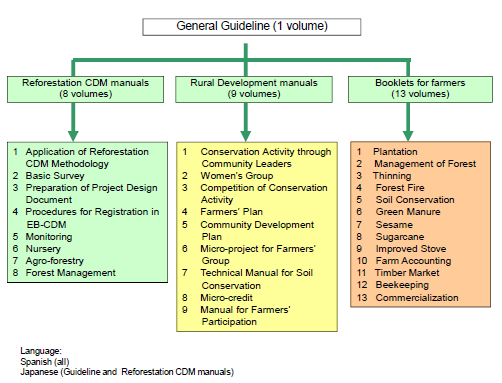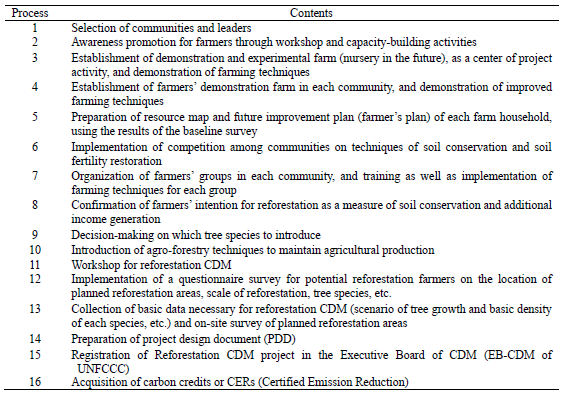Manuals on rural development applying reforestation projects under the Clean Development Mechanism (CDM)
Description
In low income rural communities, where soil erosion and soil degradation have caused deteriorating fertility, conservation activities and improvement of farming technologies with low-input methods such as the construction of contour ridges, planting of hedges on contours, and introducing green manure, as well as introducing reforestation and agroforestry in abandoned lands, are effective means in order to recover land resources and augment the landowners’ livelihood. Reforestation CDM is a system enabling project promoters to obtain carbon credits (CERs or Certified Emission Reductions) from CO2 which is accumulated in trees, as additional income, and is adaptable to soil degraded-areas suitable for planting trees, although the requirements to formulate the CDM project are too stringent to comply with. JIRCAS prepared the manuals for formulating and implementing rural development projects in low income communities in Paraguay, which include soil conservation, soil restoration and reforestation CDM, based on the results of a study jointly conducted with the National University of Asunción, Ministry of Agriculture and Livestock, etc.
The manuals consist of 1) a General Guideline, describing the processes and main points for rural development using reforestation CDM, 2) Rural development manuals based on soil conservation and restoration of soil fertility, 3) Reforestation CDM manuals to formulate and implement small-scale reforestation CDM projects, and 4) booklets for farmers, simply explaining individual farming techniques. (Fig. 1)
The objectives of the rural development process that JIRCAS established (Table 1) are to ensure motivation of participant farmers and strengthen their activities for soil conservation, improvement of farming, agro-forestry and reforestation under their own responsibility, by means of implementing awareness-heightening activities at the very initial stages of the project. Farmers with high awareness and independence are able to appropriately manage their crop fields and forested areas, to increase CO2 stock in reforested areas, to obtain carbon credits, and to realize the recovery of land resources and improvement of livelihood, by continuing the learned improved technologies.
The manuals are of highly practical use, since their effectiveness was confirmed through a verification of this unprecedented rural development model, which was implemented by combining low-input soil conservation, agro-forestry and reforestation CDM in low income communities. The manuals, prepared in Spanish and Japanese, are applicable to rural development in areas in South America, under similar natural and socio-economic conditions, and available for engineers and extension workers of governments, donor agencies, NGOs, etc. It takes around 5 years for the project promoter to achieve the objectives if the project targets unorganized small-scale farmers, though shortening of the project period is possible if cooperatives or farmers’ group are the principal beneficiaries.
Figure, table
-
Fig.1 Composition of manuals for rural development applying reforestation CDM -
Table 1 Process of rural development applying reforestation CDM
- Affiliation
-
Japan International Research Center for Agricultural Sciences Rural Development Planning Division
- Classification
-
Research
- Term of research
-
FY2008~2010
- Responsible researcher
-
MATSUBARA Eiji ( Rural Development Planning Division )
HIROUCHI Sinji ( Rural Development Planning Division )
WATANABE Mamoru ( Rural Development Planning Division )
IKEURA Hiroshi ( Rural Development Planning Division )
- ほか
- Publication, etc.
-
JIRCAS Working Report No.67 (2010)
- Japanese PDF


